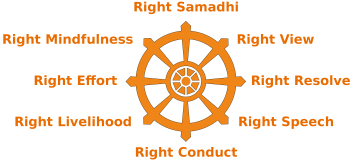Mindfulness
| Type | Team Size | ||||||
|---|---|---|---|---|---|---|---|
| Me, Myself and I | Group Collaboration | The Academic System | Software | 1 | 2-10 | 11-30 | 30+ |
What, Why & When

Mindfulness is a concept with diverse facets. In principle, it aims at clearing your mind to be in the here and now, independent of the normative assumptions that typically form our train of thought. Most people that practice mindfulness have a routine and regular rhythm, and often follow one of the several schools of thinking that exist. Mindfulness has been practiced since thousands of years, already starting before the rise of Buddhism, and in the context of many diverse but often religious schools of thinking.
Goals
Since the goal of mindfulness is basically having "no mind", it is counterintuitive to approach the practice with any clear goal. Pragmatically speaking, one could say that mindfulness practices are known to help people balance feelings of anxiety, stress and unhappiness. Many psychological challenges thus seem to show positive developments due to mindfulness practice. Traditionally, mindfulness is the seventh of the eight parts of the buddhist practice aiming to become free.
Getting started
The easiest form of mindfulness is to sit in an upright position, and to breathe in, and breathe out. Counting your breath and trying to breathe deeply and calmly is the most fundamental mindfulness exercises. As part of the noble eightfold path in Buddhism, mindfulness became a key practice in Eastern monastic cultures ranging across Asia. Zazen – sitting meditation – is a key approach in Zen Buddhism, whereas other schools of Buddhism have different approaches. Common approaches try to explore the origins of our thoughts and emotions, or our interconnectedness with other people.

During the last decades mindfulness took a strong tooting in the western world, and the commercialisation of the principle of mindfulness led to the development of several approaches and even apps, like Headspace, that can introduce lay people to a regular practice. The Internet contains many resources, yet it should be stressed that such approaches are often far away from the original starting point of mindfulness.
Mindfulness has been hyped as yet another self-optimisation tool. However, mindfulness is not an end in itself, but can be seen as a practice of a calm mind. Sweeping the floor is a common metaphor for emptying your mind. Our mind is constantly rambling around – often referred to as the monkey mind –, but there are several steps to recognise, interact with, train and finally calm your monkey mind (for tips on how to quiet the monkey mind, have a look at this article). Just like sports, mindfulness exercises are a practice where one gets better over time.
If you want to establish a mindfulness practice for yourself, you could try out the app Headspace or the aforementioned breathing exercises. Other ideas that you can find online include journaling, doing a body scan, or even Yoga. You could also start by going on a walk by yourself in nature without any technical distractions – just observing what you can see, hear, or smell. Mindfulness is a practice you can implement in everyday activities like doing the dishes, cleaning, or eating a meal as well. The goal here is to stay in the present moment without seeking distractions or judging situations. Another common mindfulness practice is writing a gratitude journal, which can help you to become more aware of the things we can be grateful for in live. This practice has proven to increase the well being of many people, and is a good mindfulness approach for people that do not want to get into a mediation. Yoga, Tai Chi and other physical body exercises can have strong components of mindfulness as well. You will find that a regular mindfulness practice helps you relieve stress and fear, can increase feelings of peace and gratitude, and generally makes you feel more calm and focused. Try it out!
Links & Further Reading
- Headspace
- A YouTube-Video for a 10-Minute Mindfulness Meditation
- Thich Nhat Hanh Foundation - Be Mindful in Daily Life
- A Wikipedia overview on Zen Mind, Beginner's Mind is classic introduction to Zen.
- Forbes. Science-based tricks for quieting the monkey mind.
The authors of this entry are Henrik von Wehrden and Katharina Kirn.